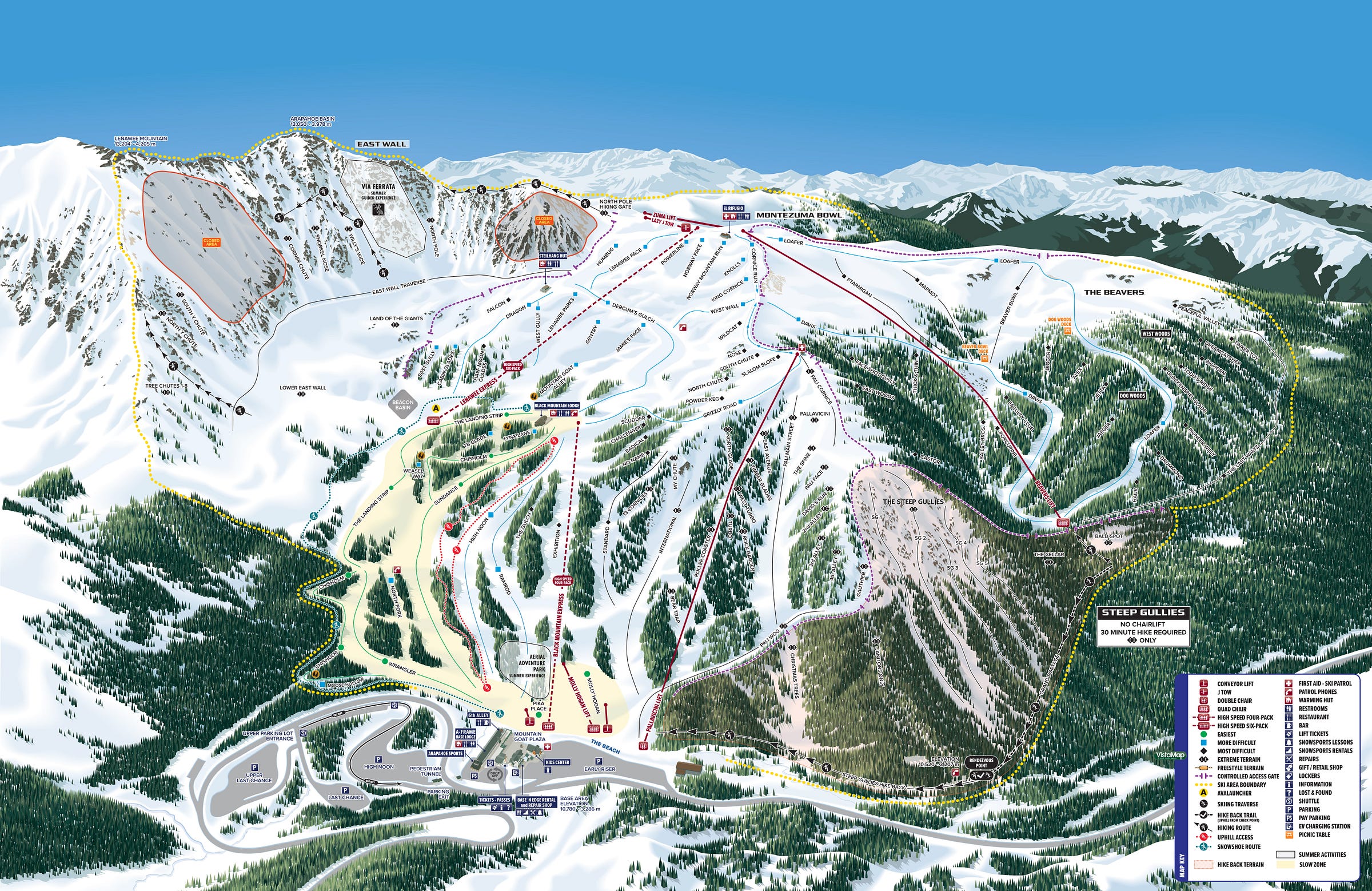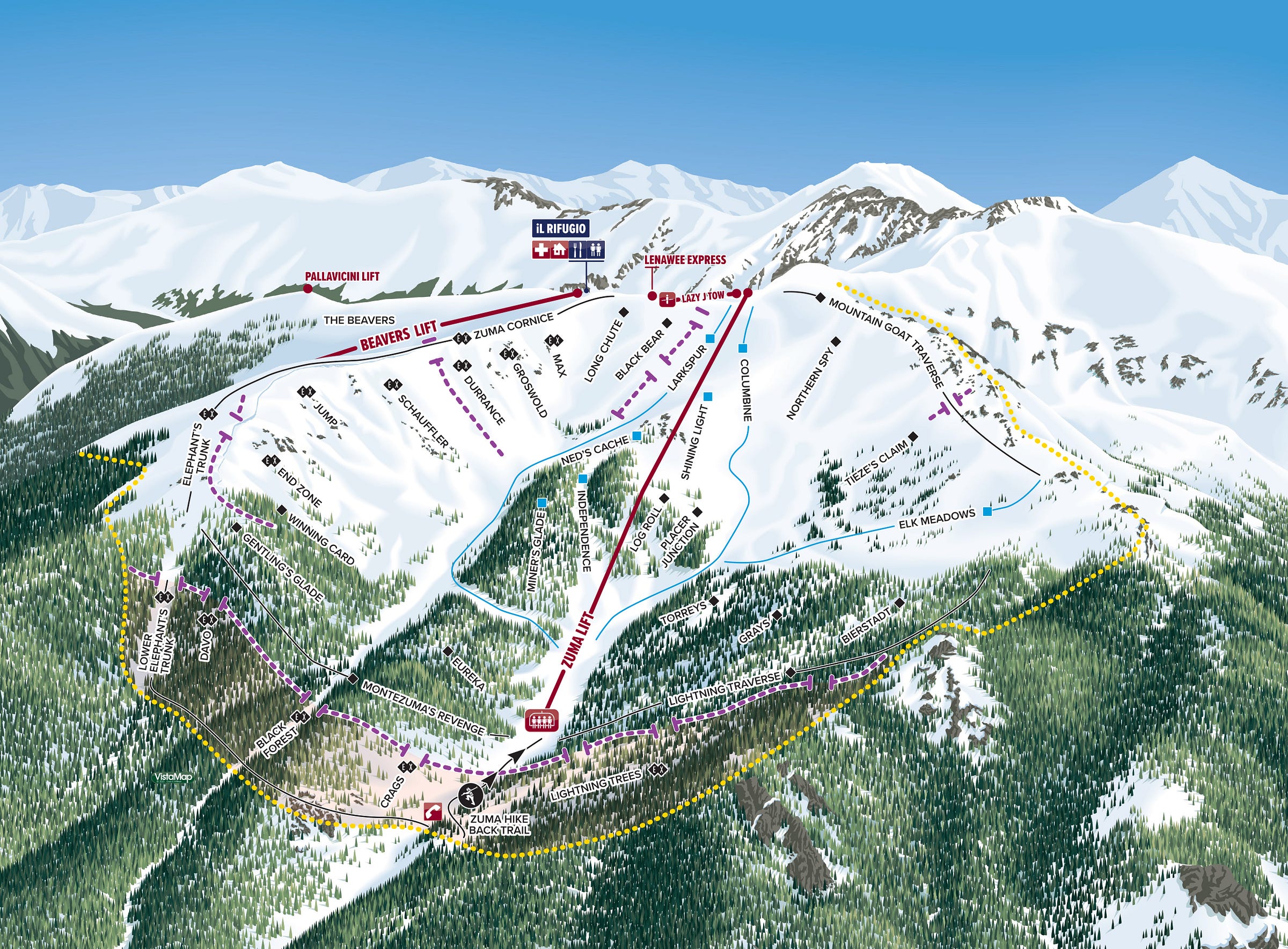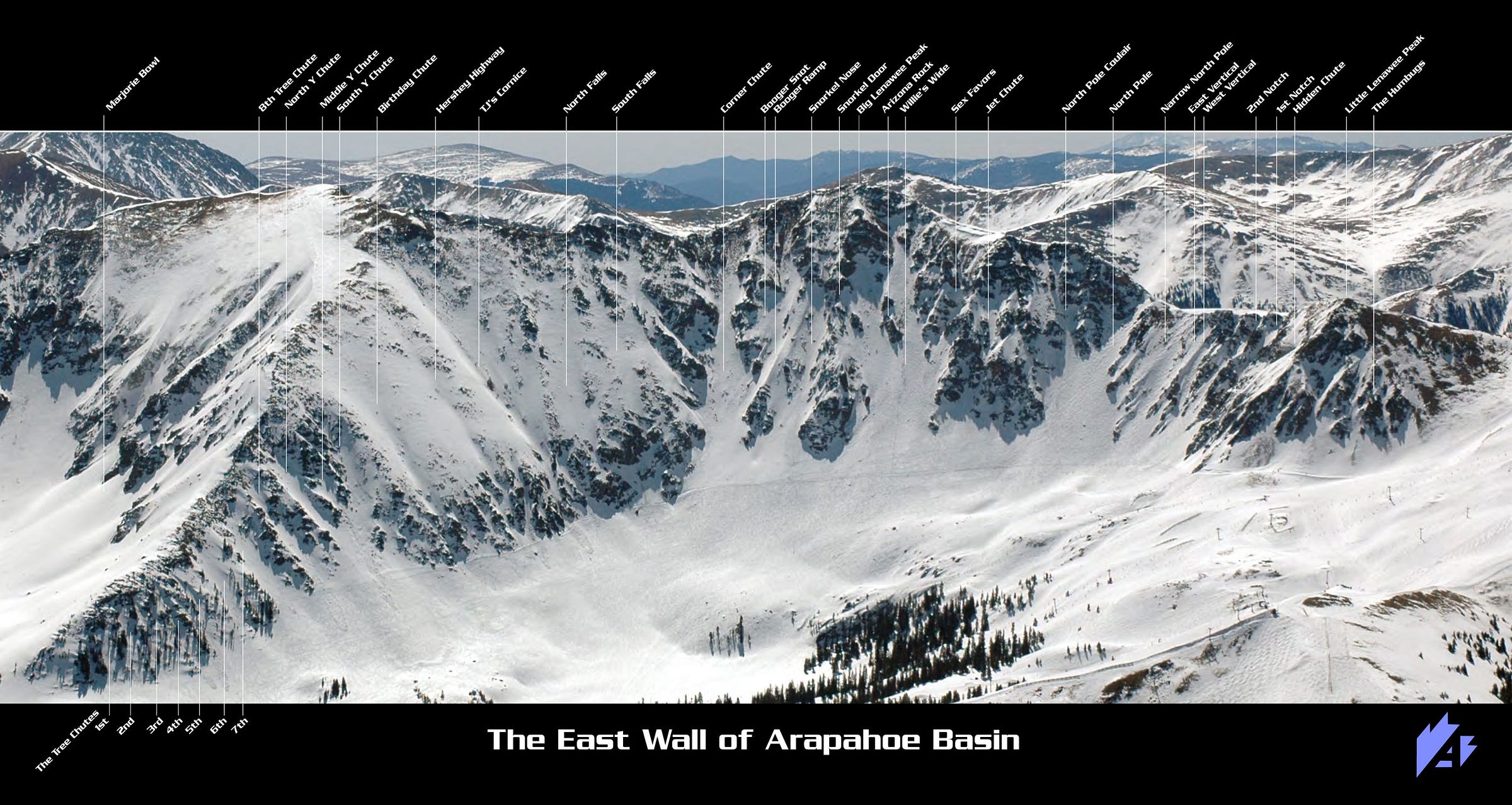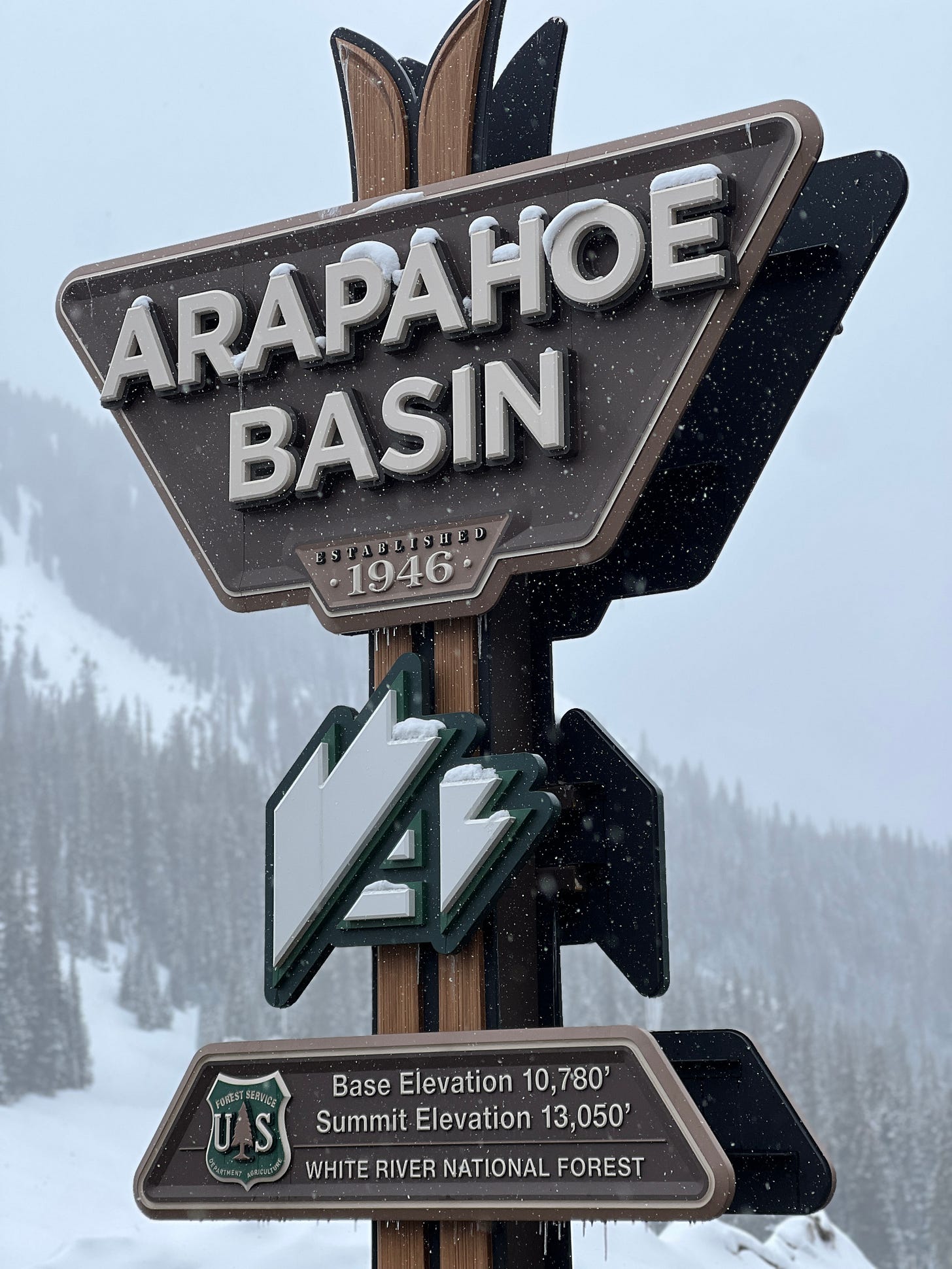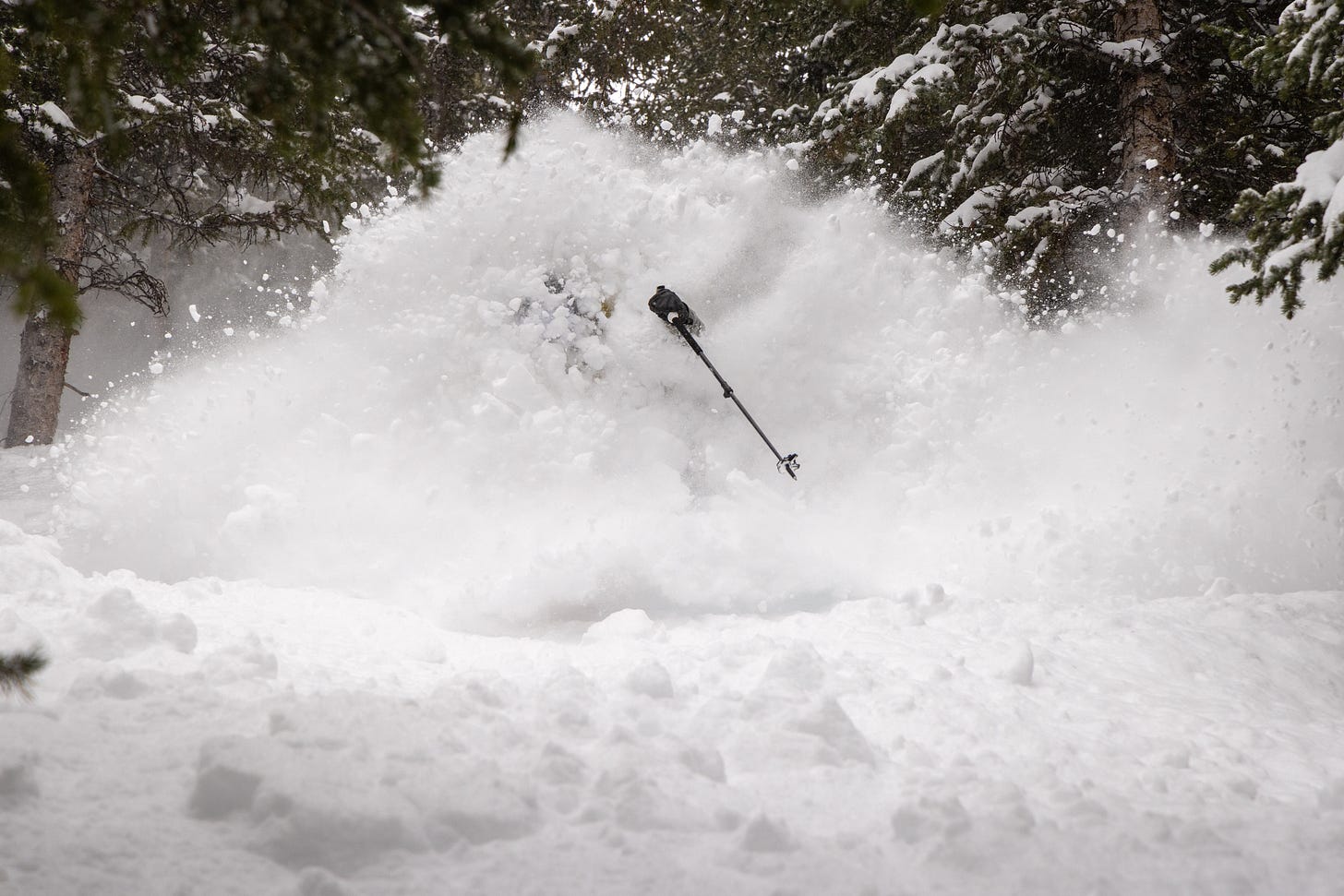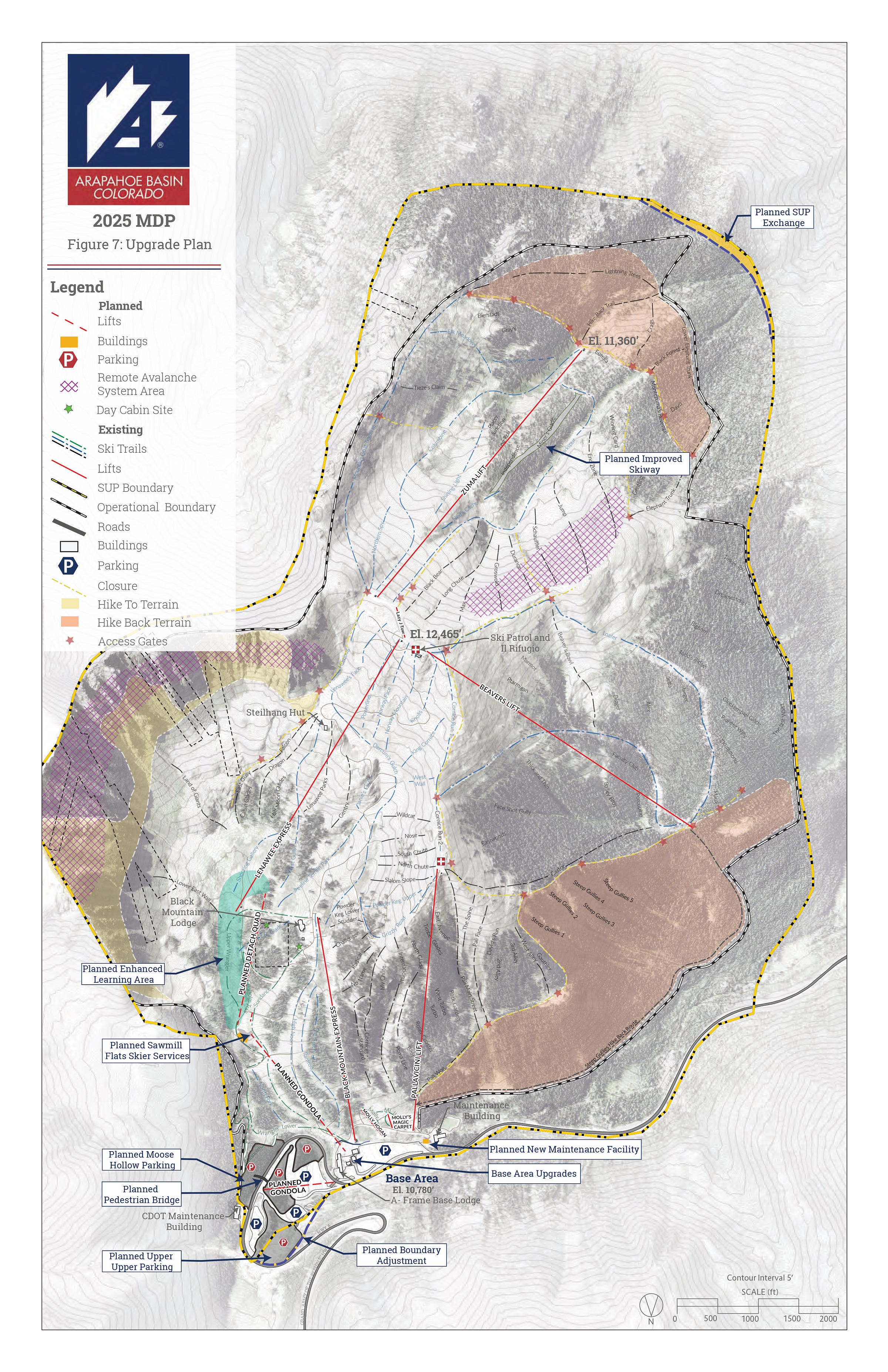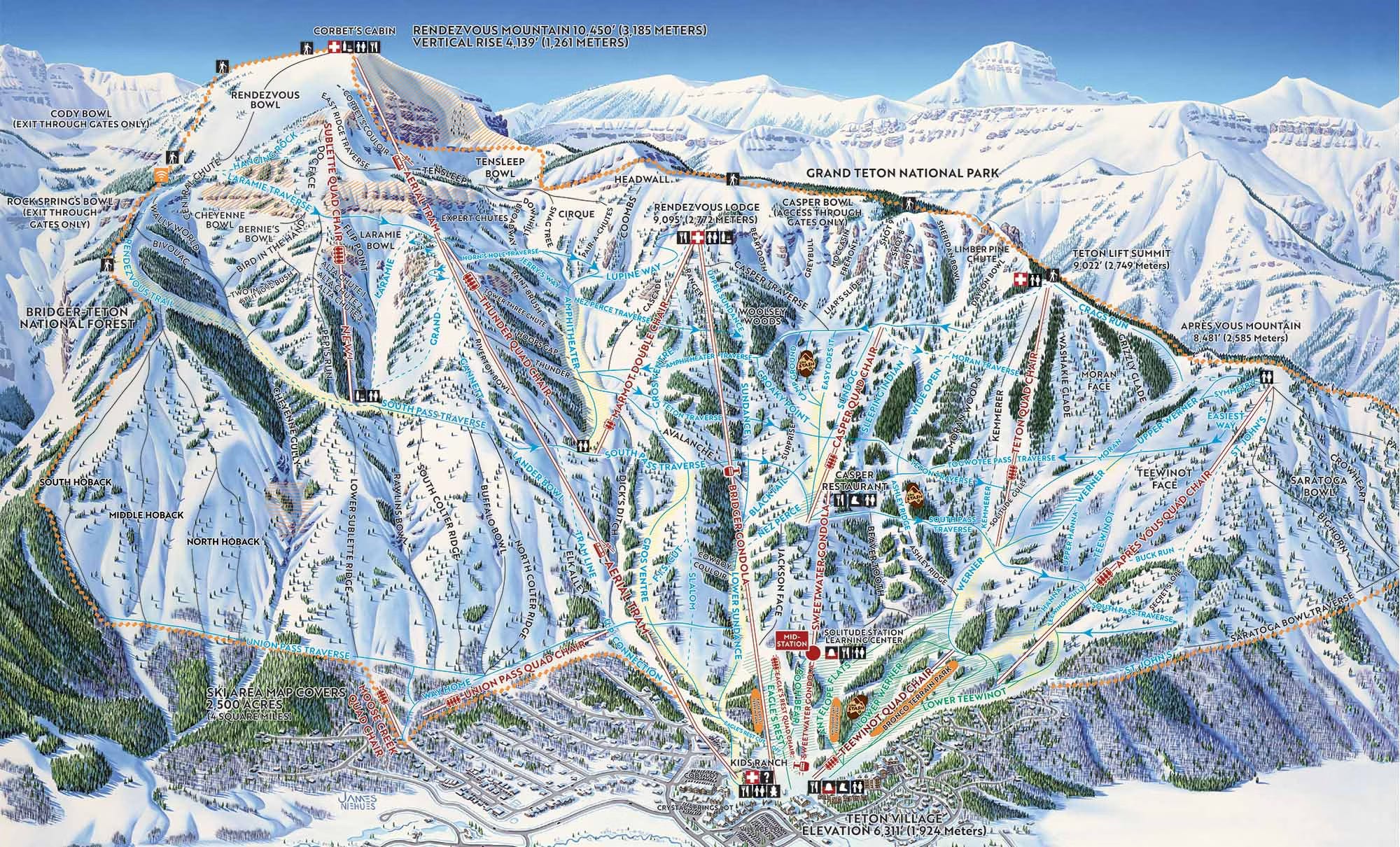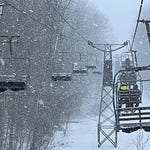Who
Alan Henceroth, President and Chief Operating Officer of Arapahoe Basin, Colorado – Al runs the best ski area-specific executive blog in America – check it out:
Recorded on
May 19, 2025
About Arapahoe Basin
Click here for a mountain stats overview
Owned by: Alterra Mountain Company, which also owns:
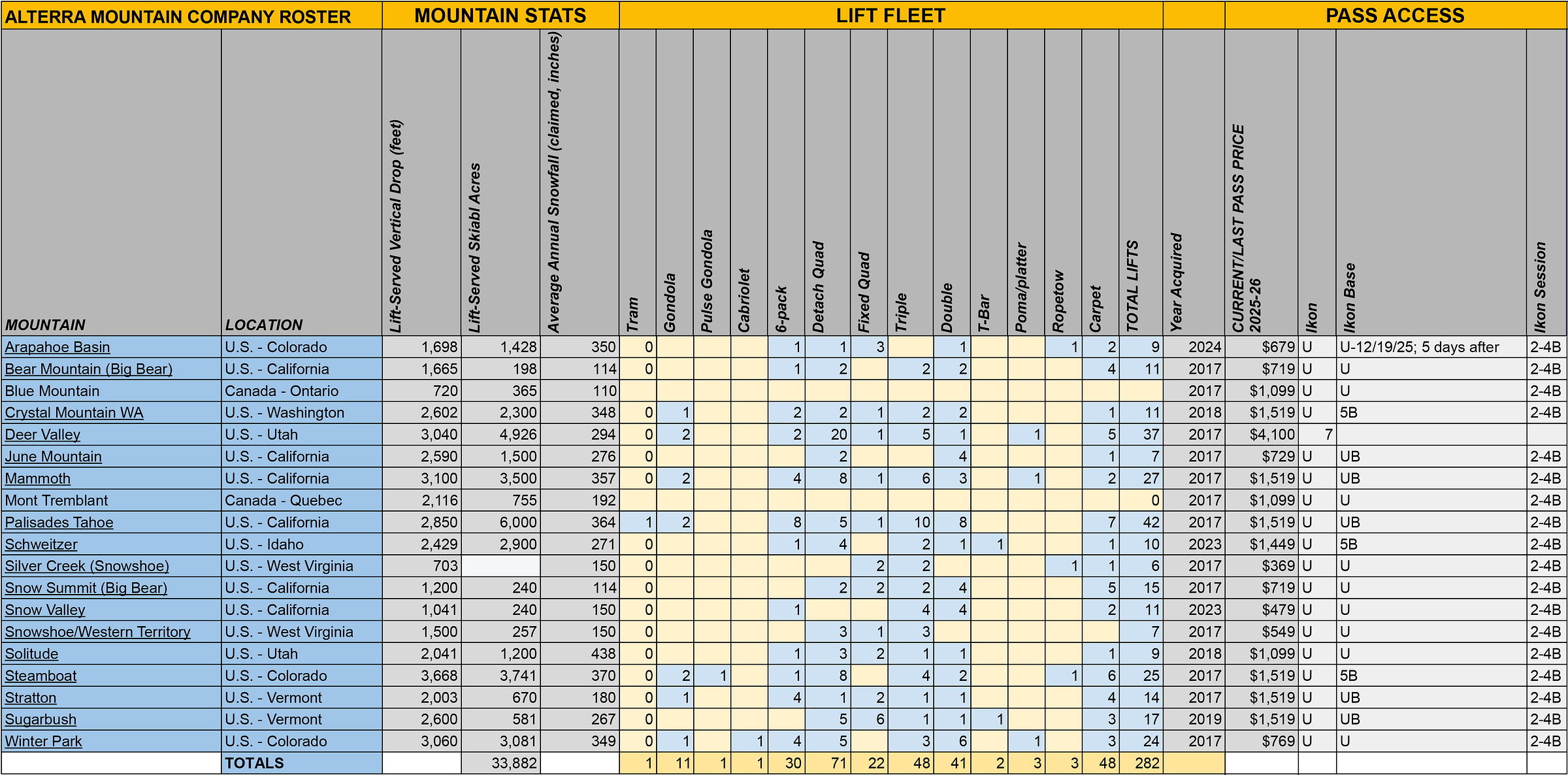
Pass access
Ikon Pass: unlimited
Ikon Base Pass: unlimited access from opening day to Friday, Dec. 19, then five total days with no blackouts from Dec. 20 until closing day 2026
Base elevation
10,520 feet at bottom of Steep Gullies
10,780 feet at main base
Summit elevation
13,204 feet at top of Lenawee Mountain on East Wall
12,478 feet at top of Lazy J Tow (connector between Lenawee Express six-pack and Zuma quad)
Vertical drop
1,695 feet lift-served – top of Lazy J Tow to main base
1,955 feet lift-served, with hike back up to lifts – top of Lazy J Tow to bottom of Steep Gullies
2,424 feet hike-to – top of Lenawee Mountain to Main Base
Skiable Acres: 1,428
Average annual snowfall:
Claimed: 350 inches
Bestsnow.net: 308 inches
Trail count: 147 – approximate terrain breakdown: 24% double-black, 49% black, 20% intermediate, 7% beginner
Lift count: 9 (1 six-pack, 1 high-speed quad, 3 fixed-grip quads, 1 double, 2 carpets, 1 ropetow)
Why I interviewed him
We can generally splice U.S. ski centers into two categories: ski resort and ski area. I’ll often use these terms interchangeably to avoid repetition, but they describe two very different things. The main distinction: ski areas rise directly from parking lots edged by a handful of bunched utilitarian structures, while ski resorts push parking lots into the next zipcode to accommodate slopeside lodging and commerce.
There are a lot more ski areas than ski resorts, and a handful of the latter present like the former, with accommodations slightly off-hill (Sun Valley) or anchored in a near-enough town (Bachelor). But mostly the distinction is clear, with the defining question being this: is this a mountain that people will travel around the world to ski, or one they won’t travel more than an hour to ski?
Arapahoe Basin occupies a strange middle. Nothing in the mountain’s statistical profile suggests that it should be anything other than a Summit County locals hang. It is the 16th-largest ski area in Colorado by skiable acres, the 18th-tallest by lift-served vertical drop, and the eighth-snowiest by average annual snowfall. The mountain runs just six chairlifts and only two detachables. Beginner terrain is limited. A-Basin has no base area lodging, and in fact not much of a base area at all. Altitude, already an issue for the Colorado ski tourist, is amplified here, where the lifts spin from nearly 11,000 feet. A-Basin should, like Bridger Bowl in Montana (upstream from Big Sky) or Red River in New Mexico (across the mountain from Taos) or Sunlight in Colorado (parked between Aspen and I-70), be mostly unknown beside its heralded big-name neighbors (Keystone, Breck, Copper).
And it sort of is, but also sort of isn’t. Like tiny (826-acre) Aspen Mountain, A-Basin transcends its statistical profile. Skiers know it, seek it, travel for it, cross it off their lists like a snowy Eiffel Tower. Unlike Aspen, A-Basin has no posse of support mountains, no grided downtown spilling off the lifts, no Kleenex-level brand that stands in for skiing among non-skiers. And yet Vail tried buying the bump in 1997, and Alterra finally did in 2024. Meanwhile, nearby Loveland, bigger, taller, snowier, higher, easier to access with its trip-off-the-interstate parking lots, is still ignored by tourists and conglomerates alike.
Weird. What explains A-Basin’s pull? Onetime and future Storm guest Jackson Hogen offers, in his Snowbird Secrets book, an anthropomorphic explanation for that Utah powder dump’s aura:
As it turns out, everyone has a story for how they came to discover Snowbird, but no one knows the reason. Some have the vanity to think they picked the place, but the wisest know the place picked them.
That is the secret that Snowbird has slipped into our subconscious; deep down, we know we were summoned here. We just have to be reminded of it to remember, an echo of the Platonic notion that all knowledge is remembrance. In the modern world we are so divorced from our natural selves that you would think we’d have lost the power to hear a mountain call us. And indeed we have, but such is the enormous reach of this place that it can still stir the last seed within us that connects us to the energy that surrounds us every day yet we do not see. The resonance of that tiny, vibrating seed is what brings us here, to this extraordinary place, to stand in the heart of the energy flow.
Yeah I don’t know, Man. We’re drifting into horoscope territory here. But I also can’t explain why we all like to do This Dumb Thing so much that we’ll wrap our whole lives around it. So if there is some universe force, what Hogen calls “vibrations” from Hidden Peak’s quartz, drawing skiers to Snowbird, could there also be some proton-kryptonite-laserbeam shit sucking us all toward A-Basin? If there’s a better explanation, I haven’t found it.
What we talked about
The Beach; keeping A-Basin’s whole ski footprint open into May; Alterra buys the bump – “we really liked the way Alterra was doing things… and letting the resorts retain their identity”; the legacy of former owner Dream; how hardcore, no-frills ski area A-Basin fits into an Alterra portfolio that includes high-end resorts such as Deer Valley and Steamboat; “you’d be surprised how many people from out of state ski here too”; Ikon as Colorado sampler pack (or not); local reaction to Alterra’s purchase – “I think it’s fair that there was anxiety”; balancing the wild ski cycle of over-the-top peak days and soft periods; parking reservations; going unlimited on the full Ikon Pass and how parking reservations play in – “we spent a ridiculous amount of time talking about it”; the huge price difference between Epic and Ikon and how that factors into the access calculus; why A-Basin still sells a single-mountain season pass; whether reciprocal partnerships with Monarch and Silverton will remain in place; “I’ve been amazed at how few things I’ve been told to do” by Alterra; A-Basin’s dirt-cheap early-season pass; why early season is “a more competitive time” than it used to be; why A-Basin left Mountain Collective; Justice Department anti-trust concerns around Alterra’s A-Basin purchase – “it never was clear to me what the concerns were”; breaking down A-Basin’s latest U.S. Forest Service masterplan – “everything in there, we hope to do”; a parking lot pulse gondola and why that makes sense over shuttles; why A-Basin plans a two-lift system of beginner machines; why should A-Basin care about beginner terrain?; is beginner development is related to Ikon Pass membership?; what it means that the MDP designs for 700 more skiers per day; assessing the Lenawee Express sixer three seasons in; why A-Basin sold the old Lenawee lift to independent Sunlight, Colorado; A-Basin’s patrol unionizing; and 100 percent renewable energy.
What I got wrong
I said that A-Basin was the only mountain that had been caught up in antitrust issues, but that’s inaccurate: when S-K-I and LBO Enterprises merged into American Skiing Company in 1996, the U.S. Justice Department compelled the combined company to sell Cranmore and Waterville Valley, both in New Hampshire. Waterville Valley remains independent. Cranmore stayed independent for a while, and has since 2010 been owned by Fairbank Group, which also owns Jiminy Peak in Massachusetts and operates Bromley, Vermont.
I said that A-Basin’s $259 early-season pass, good for unlimited access from opening day through Dec. 25, “was like one day at Vail,” which is sort of true and sort of not. Vail Mountain’s day-of lift ticket will hit $230 from Nov. 14 to Dec. 11, then increase to $307 or $335 every day through Christmas. All Resorts Epic Day passes, which would get skiers on the hill for any of those dates, currently sell for between $106 and $128 per day. Unlimited access to Vail Mountain for that full early-season period would require a full Epic Pass, currently priced at $1,121.
This doesn’t contradict anything we discussed, but it’s worth noting some parking reservations changes that A-Basin implemented following our conversation. Reservations will now be required on weekends only, and from Jan. 3 to May 3, a reduction from 48 dates last winter to 36 for this season. The mountain will also allow skiers to hold four reservations at once, doubling last year’s limit of two.
Why now was a good time for this interview
One of the most striking attributes of modern lift-served skiing is how radically different each ski area is. Panic over corporate hegemony power-stamping each child mountain into snowy McDonald’s clones rarely survives past the parking lot. Underscoring the point is neighboring ski areas, all over America, that despite the mutually intelligible languages of trail ratings and patrol uniforms and lift and snowgun furniture, and despite sharing weather patterns and geologic origins and local skier pools, feel whole-cut from different eras, cultures, and imaginations. The gates between Alta and Snowbird present like connector doors between adjoining hotel rooms but actualize as cross-dimensional Mario warpzones. The 2.4-mile gondola strung between the Alpine Meadows and Olympic sides of Palisades Tahoe may as well connect a baseball stadium with an opera house. Crossing the half mile or so between the summits of Sterling at Smugglers’ Notch and Spruce Peak at Stowe is a journey of 15 minutes and five decades. And Arapahoe Basin, elder brother of next-door Keystone, resembles its larger neighbor like a bat resembles a giraffe: both mammals, but of entirely different sorts. Same with Sugarbush and Mad River Glen, Vermont; Sugar Bowl, Donner Ski Ranch, and Boreal, California; Park City and Deer Valley, Utah; Killington and Pico, Vermont; Highlands and Nub’s Nob, Michigan; Canaan Valley and Timberline and Nordic-hybrid White Grass, West Virginia; Aspen’s four Colorado ski areas; the three ski areas sprawling across Mt. Hood’s south flank; and Alpental and its clump of Snoqualmie sisters across the Washington interstate. Proximity does not equal sameness.
One of The Storm’s preoccupations is with why this is so. For all their call-to-nature appeal, ski areas are profoundly human creations, more city park than wildlife preserve. They are sculpted, managed, manicured. Even the wildest-feeling among them – Mount Bohemia, Silverton, Mad River Glen – are obsessively tended to, ragged by design.
A-Basin pulls an even neater trick: a brand curated for rugged appeal, scaffolded by brand-new high-speed lifts and a self-described “luxurious European-style bistro.” That the Alterra Mountain Company-owned, megapass pioneer floating in the busiest ski county in the busiest ski state in America managed to retain its rowdy rap even as the onetime fleet of bar-free double chairs toppled into the recycling bin is a triumph of branding.
But also a triumph of heart. A-Basin as Colorado’s Alta or Taos or Palisades is a title easily ceded to Telluride or Aspen Highlands, similarly tilted high-alpiners. But here it is, right beside buffed-out Keystone, a misunderstood mountain with its own wild side but a fair-enough rap as an approachable landing zone for first-time Rocky Mountain explorers westbound out of New York or Ohio. Why are A-Basin and Keystone so different? The blunt drama of A-Basin’s hike-in terrain helps, but it’s more enforcer than explainer. The real difference, I believe, is grounded in the conductor orchestrating this mad dance.
Since Henceroth sat down in the COO chair 20 years ago, Keystone has had nine president-general manager equivalents. A-Basin was already 61 years old in 2005, giving it a nice branding headstart on younger Keystone, born in 1970. But both had spent nearly two decades, from 1978 to 1997, co-owned by a dogfood conglomerate that often marketed them as one resort, and the pair stayed glued together on a multimountain pass for a couple of decades afterward.
Henceroth, with support and guidance from the real-estate giant that owned A-Basin in the Ralston-Purina-to-Alterra interim, had a series of choices to make. A-Basin had only recently installed snowmaking. There was no lift access to Zuma Bowl, no Beavers. The lift system consisted of three double chairs and two triples. Did this aesthetic minimalism and pseudo-independence define A-Basin? Or did the mountain, shaped by the generations of leaders before Henceroth, hold some intangible energy and pull, that thing we recognize as atmosphere, culture, vibe? Would The Legend lose its duct-taped edge if it:
Expanded 400 mostly low-angle acres into Zuma Bowl (2007)
Joined Vail Resorts’ Epic Pass (2009)
Installed the mountain’s first high-speed lift (Black Mountain Express in 2010)
Expand 339 additional acres into the Beavers (2018), and service that terrain with an atypical-for-Colorado 1,501-vertical-foot fixed-grip lift
Exit the Epic Pass following the 2018-19 ski season
Immediately join Mountain Collective and Ikon as a multimountain replacement (2019)
Ditch a 21-year-old triple chair for the mountain’s first high-speed six-pack (2022)
Sell to Alterra Mountain Company (2024)
Require paid parking reservations on high-volume days (2024)
Go unlimited on the Ikon Pass and exit Mountain Collective (2025)
Release an updated USFS masterplan that focuses largely on the novice ski experience (2025)
That’s a lot of change. A skier booted through time from Y2K to October 2025 would examine that list and conclude that Rad Basin had been tamed. But ski a dozen laps and they’d say well not really. Those multimillion upgrades were leashed by something priceless, something human, something that kept them from defining what the mountain is. There’s some indecipherable alchemy here, a thing maybe not quite as durable as the mountain itself, but rooted deeper than the lift towers strung along it. It takes a skilled chemist to cook this recipe, and while they’ll never reveal every secret, you can visit the restaurant as many times as you’d like.
Why you should ski Arapahoe Basin
We could do a million but here are nine:
1) $: Two months of early-season skiing costs roughly the same as A-Basin’s neighbors charge for a single day. A-Basin’s $259 fall pass is unlimited from opening day through Dec. 25, cheaper than a Dec. 20 day-of lift ticket at Breck ($281), Vail ($335), Beaver Creek ($335), or Copper ($274), and not much more than Keystone ($243).
2) Pali: When A-Basin tore down the 1,329-vertical-foot, 3,520-foot-long Pallavicini double chair, a 1978 Yan, in 2020, they replaced it with a 1,325-vertical-foot, 3,512-foot-long Leitner-Poma double chair. It’s one of just a handful of new doubles installed in America over the past decade, underscoring a rare-in-modern-skiing commitment to atmosphere, experience, and snow preservation over uphill capacity.
3) The newest lift fleet in the West: The oldest of A-Basin’s six chairlifts, Zuma, arrived brand-new in 2007.
4) Wall-to-wall: when I flew into Colorado for a May 2025 wind-down, five ski areas remained open. Despite solid snowpack, Copper, Breck, and Winter Park all spun a handful of lifts on a constrained footprint. But A-Basin and Loveland still ran every lift, even over the Monday-to-Thursday timeframe of my visit.
5) The East Wall: It’s like this whole extra ski area. Not my deal as even skiing downhill at 12,500 feet hurts, but some of you like this shit:
6) May pow: I mean yeah I did kinda just get lucky but damn these were some of the best turns I found all year (skiing with A-Basin Communications Manager Shayna Silverman):
7) The Beach: the best ski area tailgate in North America (sorry, no pet dragons allowed - don’t shoot the messenger):
8) The Beavers: Just glades and glades and glades (a little crunchy on this run, but better higher up and the following day):
9) It’s a ski area first: In a county of ski resorts, A-Basin is a parking-lots-at-the-bottom-and-not-much-else ski area. It’s spare, sparse, high, steep, and largely exposed. Skiers are better at self-selecting than we suppose, meaning the ability level of the average A-Basin skier is more Cottonwoods than Connecticut. That impacts your day in everything from how the liftlines flow to how the bumps form to how many zigzaggers you have to dodge on the down.
Podcast Notes
On the dates of my visit
We reference my last A-Basin visit quite a bit – for context, I skied there May 6 and 7, 2025. Both nice late-season pow days.
On A-Basin’s long seasons
It’s surprisingly difficult to find accurate open and close date information for most ski areas, especially before 2010 or so, but here’s what I could cobble together for A-Basin - please let me know if you have a more extensive list, or if any of this is wrong:
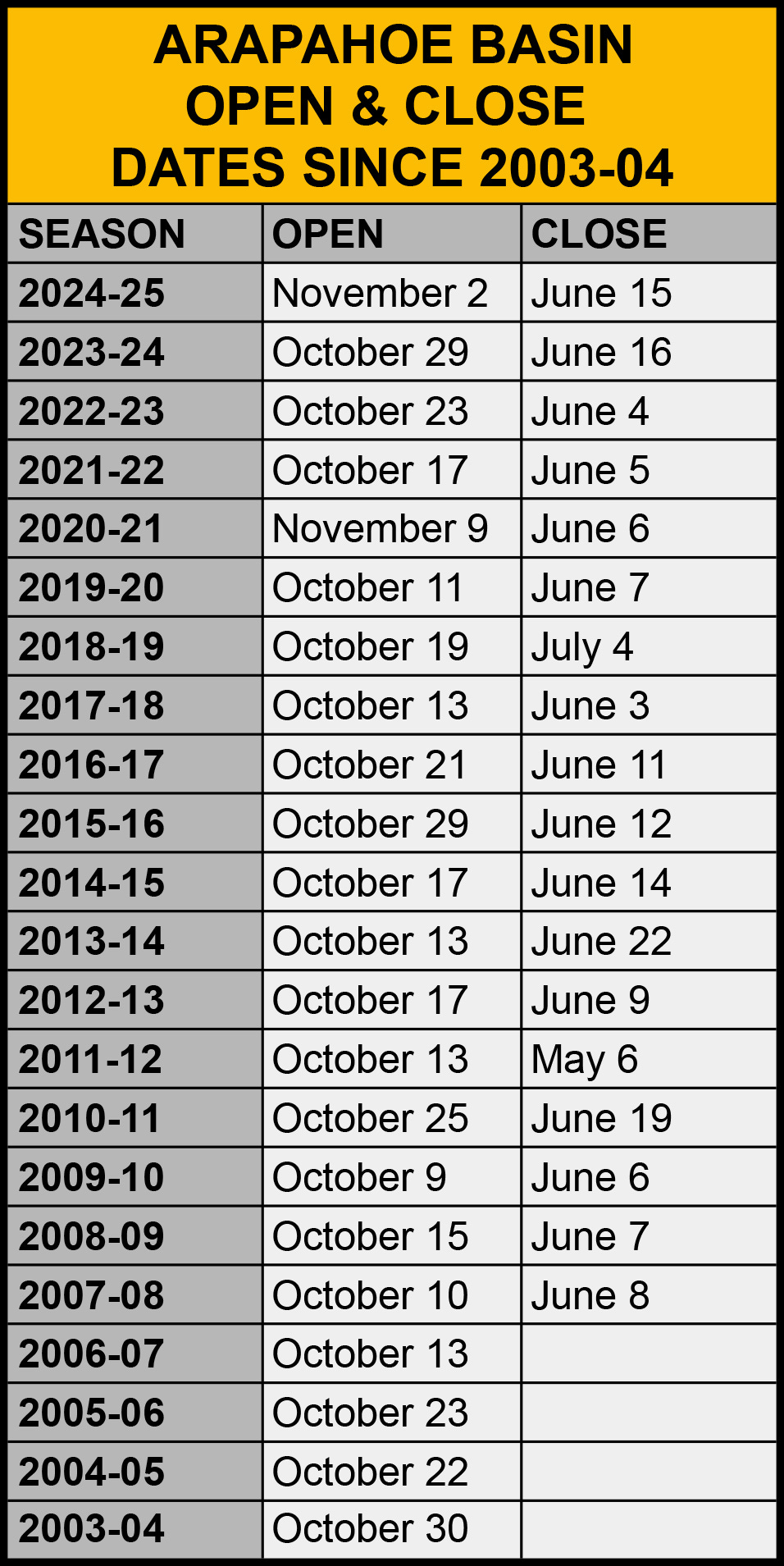
On A-Basin’s ownership timeline
Arapahoe Basin probably gets too much credit for being some rugged indie. Ralston-Purina, then-owners of Keystone, purchased A-Basin in 1978, then added Breckenridge to the group in 1993 before selling the whole picnic basket to Vail in 1997. The U.S. Justice Department wouldn’t let the Eagle County operator have all three, so Vail flipped Arapahoe to a Canadian real estate empire, then called Dundee, some months later. That company, which at some point re-named itself Dream, pumped a zillion dollars into the mountain before handing it off to Alterra last year.
On A-Basin leaving Epic Pass
A-Basin self-ejected from Epic Pass in 2019, just after Vail maxed out Colorado by purchasing Crested Butte and before they fully invaded the East with the Peak Resorts purchase. Arapahoe Basin promptly joined Mountain Collective and Ikon, swapping unlimited-access on four varieties of Epic Pass for limited-days products. Henceroth and I talked this one out during our 2022 pod, and it’s a fascinating case study in building a better business by decreasing volume.
On the price difference between Ikon and Epic with A-Basin access
Concerns about A-Basin hurdling back toward the overcrowded Epic days by switching to Ikon’s unlimited tier tend to overlook this crucial distinction: Vail sold a 2018-19 version of the Epic Pass that included unlimited access to Keystone and A-Basin for an early-bird rate of $349. The full 2025-26 Ikon Pass debuted at nearly four times that, retailing for $1,329, and just ramped up to $1,519.
On Alterra mountains with their own season passes
While all Alterra-owned ski areas (with the exception of Deer Valley), are unlimited on the full Ikon Pass and nine are unlimited with no blackouts on Ikon Base, seven of those sell their own unlimited season pass that costs less than Base. The sole unlimited season pass for Crystal, Mammoth, Palisades Tahoe, Steamboat, Stratton, and Sugarbush is a full Ikon Pass, and the least-expensive unlimited season pass for Solitude is the Ikon Base. Deer Valley leads the nation with its $4,100 unlimited season pass. See the Alterra chart at the top of this article for current season pass prices to all of the company’s mountains.
On A-Basin and Schweitzer pass partnerships
Alterra has been pretty good about permitting its owned ski areas to retain historic reciprocal partners on their single-mountain season passes. For A-Basin, this means three no-blackout days at Monarch and two unguided days at Silverton. Up at Schweitzer, passholders get three midweek days each at Whitewater, Mt. Hood Meadows, Castle Mountain, Loveland, and Whitefish. None of these ski areas are on Ikon Pass, and the benefit is only stapled to A-Basin- or Schweitzer-specific season passes.
On the Mountain Collective event
I talk about Mountain Collective as skiing’s most exclusive country club. Nothing better demonstrates that characterization than this podcast I recorded at the event last fall, when in around 90 minutes I had conversations with the top leaders of Boyne Resorts, Snowbird, Aspen, Jackson Hole, Sun Valley, Snowbasin, Grand Targhee, and many more.
On Mountain Collective and Ikon overlap
The Mountain Collective-Ikon overlap is kinda nutso:
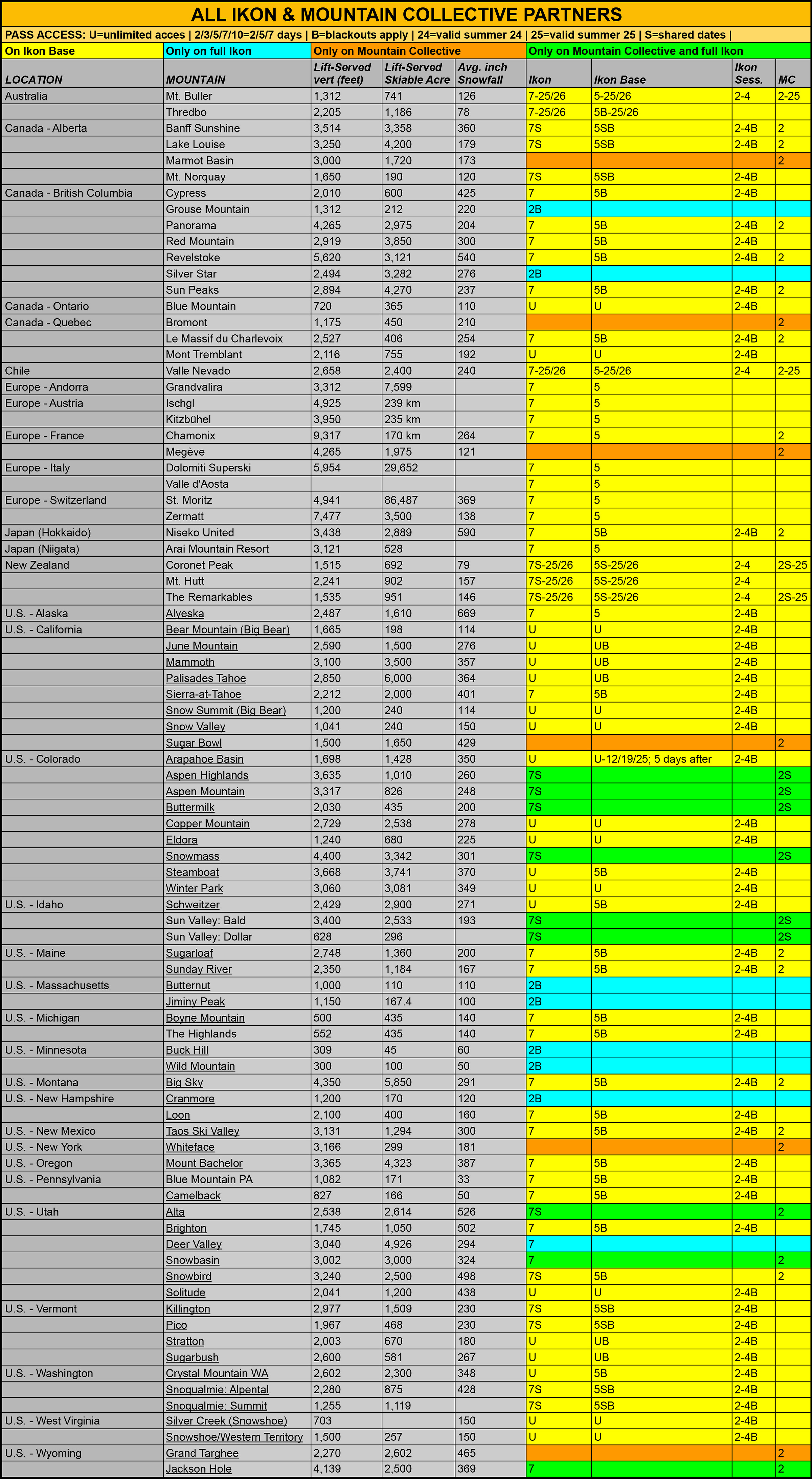
On Pennsylvania skiing
In regards to the U.S. Justice Department grilling Alterra on its A-Basin acquisition, it’s still pretty stupid that the agency allowed Vail Resorts to purchase eight of the 19 public chairlift-served ski areas in Pennsylvania without a whisper of protest. These eight ski areas almost certainly account for more than half of all skier visits in a state that typically ranks sixth nationally for attendance. Last winter, the state’s 2.6 million skier visits accounted for more days than vaunted ski states New Hampshire (2.4 million), Washington (2.3), Montana (2.2), Idaho (2.1). or Oregon (2.0). Only New York (3.4), Vermont (4.2), Utah (6.5), California (6.6), and Colorado (13.9) racked up more.
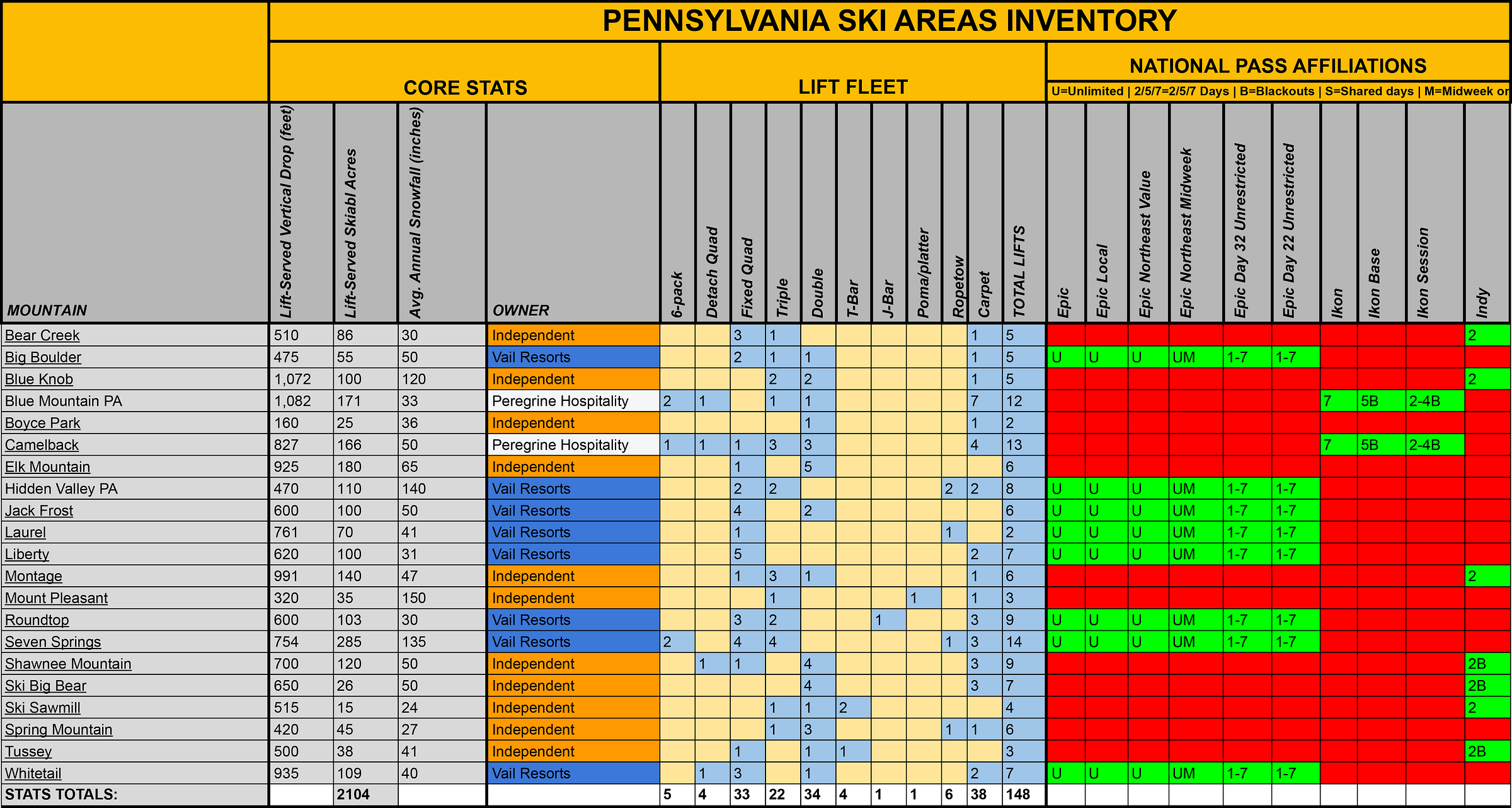
On A-Basin’s USFS masterplan
Nothing on the scale of Zuma or Beavers inbound, but the proposed changes would tap novice terrain that has always existed but never offered a good access point for beginners:
On pulse gondolas
A-Basin’s proposed pulse gondola, should it be built, would be just the sixth such lift in America, joining machines at Taos, Northstar, Steamboat, Park City, and Snowmass. Loon plans to build a pulse gondola in 2026.
On mid-mountain beginner centers
Big bad ski resorts have attempted to amp up family appeal in recent years with gondola-serviced mid-mountain beginner centers, which open gentle, previously hard-to-access terrain to beginners. This was the purpose of mid-stations off Jackson Hole’s Sweetwater Gondola and Big Sky’s new-for-this-year Explorer Gondola. A-Basin’s gondy (not the parking lot pulse gondola, but the one terminating at Sawmill Flats in the masterplan image above), would provide up and down lift access allowing greenies to lap the new detach quad above it.



